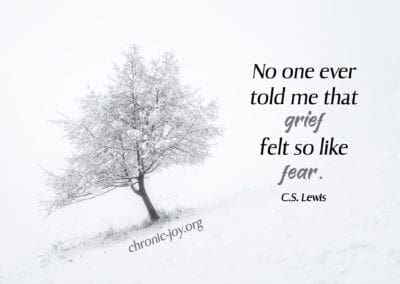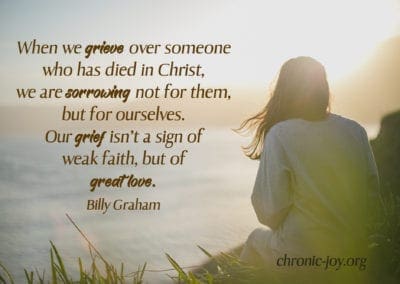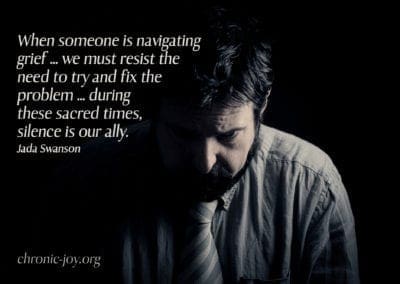
In the Midst of Grief – Creative Expression
Mourning Our Losses
Grief is no stranger to those of us affected by chronic illness, mental illness, pain, and suffering. While there are no rules for grieving chronic loss, there is a road map and there are fellow travelers ahead and behind us on the journey. Grief often precedes growth.
Now is your time of grief, but I will see you again and you will rejoice, and no one will take away your joy. (John 16:22)

CREATIVELY EXPRESSING GRIEF
When we lean into Jesus and begin to bravely recognize and express our grief with Him, He guides us on His journey for us, compassionately, gently, patiently, and creatively.
So often, the world looks colorless and grey through the lens of grief. In art, grey is a neutral, balanced color midway between black and white. In science, black is the absence of light (therefore of visible color) and white is the blending of all wavelengths of light (therefore of all color). Metaphorically, if white represents love and black represents the absence of who or what we love, then grey is the mixing together of God’s infinite love (We love because God first loves us.) and of our finite loss (who or what we love here on earth).
Seen in that way, grey is God’s holy presence with us in every loss.
More than 500 years ago, Shakespeare wrote, “Give sorrow words; the grief that does not speak knits up the o’erwrought heart and bids it break.”
CREATIVITY HELPS EXPRESS AND RELEASE EMOTIONS
Creativity helps us to see our grief differently, to look a little deeper, to discover beauty in unexpected places and surprising strokes of color in our landscapes of loss. Grief invites us to pour our sorrow into poetry, scrapbooking, pottery, painting, music, metaphor, baking, exercise, allegory, photography, journaling; serving creatively can also be a wonderful activity.
“Creativity in grief, loss, and trauma helps us express and release feelings that otherwise have no outlet, feelings we ourselves may not understand until we see them before us in a different form,” write Karla Helbert and Jamie Fueglein.
ART AFTER LOSS
“After a traumatic loss, the arts allow what can’t be spoken about to come into form,” says Sharon Strouse. “One night, I was looking to God, saying ‘Help me.’ A little voice inside of me said to make a collage. I turned a light on in the kitchen, gathered magazines and art paper and I began … The experience was life-changing … I was able to sleep for the first time in a year.”
Author and poet Priscilla Long adds, “Art beholds the beloved, remembers the beloved, makes the beloved visible. Art laments … art comforts … art refuses to forget. Art recognizes the grief … holds it, expresses it.”
CREATIVE WAYS TO EXPRESS GRIEF
- Sketch your emotions in pencil, pastels, or ink
- Begin a Tribute Scrapbook
- Start a Grief Journal
- Piece together a Memory Quilt
- Craft a Grief Mask
- Sculpt clay
- Paint a Grief Canvas
- Plant a Memory Garden
- Bake and share a favorite dessert
- Do a 365-Day Photography Project
- Start a 365-Day Gratitude Journal
- Knit or crochet prayer shawls
- Express grief through dance
- Lean into music – sing, play, or listen
“Sometimes great sorrow drives us to silence,” writes author Marilyn McEntyre, “but even in that silence, we may find ourselves wanting to find words. As we move beyond the first shock of grief, sorrow may become story, poetry, or prayer. Sometimes in a season of loss we discover a voice we didn’t know we had … Words can do sacred work.”

LAMENTING IN GRIEF
Lament is a compassionate and grace-filled invitation from God to pour out our grief over the many and often sustained losses of chronic illness, over our prodigal children and broken relationships, over lost jobs and lost homes, over loss of independence and loss of mobility, and over the death of our loved ones. We lament because sin ushered brokenness and pain into the world. Yet as we lean into this authentic expression of our pain, our capacity for joy also grows.
Pastor and author, Mark Vroegop writes, “Lament wrestles with the tension that God is good, but bad things still happen. Lament struggles with the promise that one day there will be no more pain, tears, and death (Revelation 21:4), but that day has not yet come. Lament acknowledges the ultimate cause of suffering and longs for the promised resolution.”
LAMENT IS A LANGUAGE OF PRAYER
Lament is a song of sorrow and a language of prayer. Jesus lamented and He wept. He understands our pain because He is with us in it. Often in grief, we just want someone to quietly listen with compassion. The word compassion is derived from the Latin roots, com and pati, meaning with and suffer. To suffer with is its literal translation.
Missionary Craig Thompson writes, “If only we could all acknowledge each other’s grief—however we label it. Then we could share openly and honestly. Then we could listen with compassion. Then we could sit down next to someone, with empathy—or sympathy—and ‘mourn with those who mourn.’ Then we could give and receive the community we need.”
Author, speaker, and Bible teacher Whitney Wollard adds, “Lament allows us to fully face and name our pain, and it creates space for future resolution and hope without glossing over our trauma. It gives us permission to protest life’s difficulties, to scream, cry, vent, plead, and complain in the presence of God and others. It lets us ask the hard questions without condemnation: ‘Why did this have to happen?’ ‘How could you allow this?’ ‘Where are you in the midst of this?’ It allows weeping without explanation. It might be messy and uncomfortable, but it’s the first step towards healing.”
THE POETRY OF GRIEF
In a few lines (or even just a few words), poetry can help us express what might be too difficult, too raw, or too vulnerable to say aloud. Often in grief, we want time to stop so we can process, or to slow down so we can breathe, or to turn back and give us a chance at a different ending – anything but to simply march on. In his poem, Funeral Blues, W.H. Auden expresses it like this:
“Stop all the clocks, cut off the telephone / … Pack up the moon and dismantle the sun …”
Kevin Young describes this same juxtaposition n his poem Bereavement:
Grief might be easy
if there wasn’t still
such beauty – would be far
simpler if the silver
maple didn’t thrust
it’s leaves into flame,
trusting that spring
will find it again.
Poet Patricia McKernon Runkle calls grief a “holy madness.”
Poet Mary Oliver writes about the weight of grief in her poem:
Heavy
It’s not the weight you carry
But how you carry it –
books, bricks, grief –
it’s all in the way
you embrace it, balance it, carry it
when you cannot, and would not,
put it down.
“ … Eat the fruit of sorrow even if it is bitter,” writes John Piper. “This fruit … has nutrients in it that you can’t get any other way, nutrients that are strengthening to the bones of our faith and sweetening to the marrow of our faith …”
WHEN YOU MEET SOMEONE DEEP IN GRIEF
Patricia McKernon Runkle
Slip off your needs
and set them by the door.
Enter barefoot
this darkened chapel
hollowed by loss
hallowed by sorrow
its gray stone walls
and floor.
You, congregation
of one
are here to listen
not to sing.
Kneel in the back pew.
Make no sound.
let the candles
speak.
Patricia values the quiet work of listening to one another and building community. She has volunteered at a peer-support center for grieving children and their families, worked as a writer and editor, and directed a church choir. She has published poems, songs and collaborative choral pieces, and a memoir on grief. She lives with her husband in the New York area, and they cherish their two grown children.




Grief is a Holy Madness
“Grief is a holy madness … a wilderness we wander in search of the sacred …” (Patricia McKernon Runkle)
Dance of Life
“The dance of life finds its beginnings in grief … It is the way in which pain can be embraced, not out of a desire to suffer, but in the knowledge that something new will be born in the pain.” (Henri Nouwen)
Hope That Overwhelms Grief
“The glory of the Christian life is that we have a hope that overwhelms grief. It doesn’t eradicate it. It sweetens it. It overwhelms it.” (Timothy Keller)
Sing Sad Songs
“When you sing your sad songs, I will learn the words and sing along.” (Ellie Holcomb)
Grief is Great Love
“When we grieve over someone who has died in Christ, we are sorrowing not for them, but for ourselves. Our grief isn’t a sign of weak faith, but of great love.” (Billy Graham)
Navigating Grief
“When someone is navigating grief … we must resist the need to try and fix the problem … during these sacred times, silence is our ally.” (Jada Swanson)














